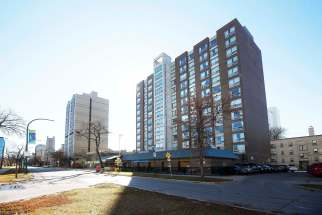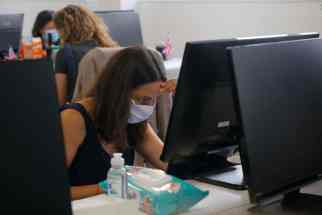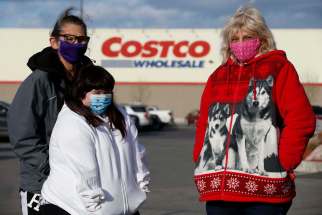Winnipeg sets daily COVID record; restrictions to be tightened Winkler man 38th Manitoban to die from virus
Read this article for free:
or
Already have an account? Log in here »
To continue reading, please subscribe:
Monthly Digital Subscription
$0 for the first 4 weeks*
- Enjoy unlimited reading on winnipegfreepress.com
- Read the E-Edition, our digital replica newspaper
- Access News Break, our award-winning app
- Play interactive puzzles
*No charge for 4 weeks then price increases to the regular rate of $19.00 plus GST every four weeks. Offer available to new and qualified returning subscribers only. Cancel any time.
Monthly Digital Subscription
$4.75/week*
- Enjoy unlimited reading on winnipegfreepress.com
- Read the E-Edition, our digital replica newspaper
- Access News Break, our award-winning app
- Play interactive puzzles
*Billed as $19 plus GST every four weeks. Cancel any time.
To continue reading, please subscribe:
Add Free Press access to your Brandon Sun subscription for only an additional
$1 for the first 4 weeks*
*Your next subscription payment will increase by $1.00 and you will be charged $16.99 plus GST for four weeks. After four weeks, your payment will increase to $23.99 plus GST every four weeks.
Read unlimited articles for free today:
or
Already have an account? Log in here »
Hey there, time traveller!
This article was published 15/10/2020 (1883 days ago), so information in it may no longer be current.
Winnipeg will be slapped with new restrictions to keep the coronavirus at bay, Manitoba’s top doctor warned, as 133 new cases of the virus were reported in the city on Thursday — setting a new daily record.
“Many Manitobans have been following the fundamentals from the beginning, but we can see we’ve lost our way,” chief provincial public health officer Dr. Brent Roussin said. “So we’re going to need to act to be able to bring down these numbers before continued escalation.”
The government will exercise its options under the orange alert level of the pandemic response system to bring in broad capacity restrictions to the province’s capital, affecting multiple sectors, by early next week, Roussin said.
The warning comes a little more than two weeks after the Winnipeg region was placed under orange alert on Sept. 28, which required masks to be worn at indoor public places and limited gatherings to 10 people. On Oct. 7, the province issued a suite of restrictions on licensed premises and ordered them to stop serving alcohol at 10 p.m., and close by 11 p.m.
Despite the restrictions, Roussin said cases continued to rise at a concerning level. In the Winnipeg region, the five-day test positivity rate reached a record high of 5.8 per cent Thursday. Provincewide, it was 4.9 per cent.
“It’s much more elevated than we can certainly tolerate,” Roussin said. “We know we need to act, both through public health interventions and through our messaging… we have to change what we’re doing right now, or else we’re going to see ongoing transmission of this virus, we’re going to see increasing test positivity rates, if we don’t get back to those fundamentals.”
“Many Manitobans have been following the fundamentals from the beginning, but we can see we’ve lost our way.”
– Chief provincial public health officer Dr. Brent Roussin
Roussin said contact tracing capabilities are being strained under the mounting caseload and public health nurses are reaching between 70 to 80 per cent of close contacts within 24 hours. In addition, investigations are becoming more complex. He said work to ramp up contact-tracing capacity in the short term is underway.
Roussin described the province’s current hospital and intensive care status as in the “green,” though he noted there are other pressures on the health and acute care systems unrelated to COVID-19 admissions. The average wait time to get through to the Health Links telephone line is about 95 minutes, the top doctor said, and the median total test turn around time is 41 hours.
How one sick person infects 40 people with COVID-19
A single gathering in Winnipeg on a Friday in September set in motion a chain of events that would spawn 40 cases of COVID-19 and send more than 240 people into isolation.
Chief provincial public health officer Dr. Brent Roussin laid out the details of how a single person who had COVID-19 passed on the contagion, highlighting the “consequences” of social gatherings.
A single gathering in Winnipeg on a Friday in September set in motion a chain of events that would spawn 40 cases of COVID-19 and send more than 240 people into isolation.
Chief provincial public health officer Dr. Brent Roussin laid out the details of how a single person who had COVID-19 passed on the contagion, highlighting the “consequences” of social gatherings.
On Sept. 11, Roussin said a person attended what he described as a “social event” while infected with the virus.
Four days later, a person, who was linked to that gathering, came down with the virus. In the roughly 96 hours that had passed, that person had accumulated 13 close contacts.
On day five, five more people were sick with COVID-19 and their infection could be traced back to the gathering on Sept. 11, Roussin said. Forty-nine close contacts were reported by the five people.
Two days later, nine more cases had been discovered and traced back to the gathering.
Those nine people had a total of 96 close contacts, including one person who had 50 close contacts.
By the 12th day, there were 40 cases of COVID-19 and 243 people were identified as close contacts and forced into self-isolation.
All were linked back to the initial exposure, Roussin said.
People who came into contact with the virus as a result of the event ranged in age from 10 to 86, and two of the contacts who eventually developed the disease were older than 50.
“We can see the significant impact of just that one exposure,” Roussin said.
“We can see that this transmission event is not from having a couple of contacts. These are large gatherings, a large amount of contacts, and we can see how quickly that adds up.”
Roussin said this one example of how the virus moved throughout the community is not unique. Public health investigators are finding that more people who become sick are reporting having more close contacts.
Roussin said there have been examples of large family gatherings, where a person attends while symptomatic, and comes into contact with more than 20 other people, and instances of people heading to bars while sick or going to their workplace.
Case counts spiked in men and women in their 20s in early September, accelerated by a number of “outbreak settings,” Roussin said, and the number of infections among people in that age range surpasses all others.
Half of the cases involving people in their 20s have an unknown exposure, he added.
A week after the spike in cases among young people, cases began to grow among individuals in their 60s.
Roussin urged people to stay home when they are sick and reduce the number of people they come into contact with outside their home.
He also acknowledged staying home can be difficult for people who have to weigh their risk against earning a paycheque, and asked employers to support their staff in limiting the spread of the virus.
“We’re not stigmatizing anyone. We’re not blaming anyone. And there’s real challenges,” Roussin said.
“Employers, if you don’t have anything in place to make staying at home easy for your employees, the alternative to that is your employees are (going) to work sick and that’s not good for business or your capacity either.
“No one’s risk is their own.”
danielle.dasilva@freepress.mb.ca
On Thursday, the province announced a 38th Manitoban had died from COVID-19 since the virus appeared in Manitoba in mid-March. The man, who lived in the Winkler area, was in his 40s and had underlying health conditions.
New cases were recorded in the following regions: Interlake–Eastern health (six), Northern (three), Prairie Mountain (eight) and Southern Health (23).
According to the province, 2,117 laboratory tests were processed on Wednesday, bringing the total since early February to 217,878. Active cases were at 1,527 and 1,533 people were considered to have recovered from the disease (the province has noted a delay in reporting recoveries).
Twenty-five people were in hospital with COVID-19, including five in intensive care.
Roussin provided few details Thursday about what the new restrictions might mean for Winnipeg, but said multiple sectors, including fitness facilities, retail, sports leagues and restaurants, will be affected and proprietors can expect widespread capacity limitations likely taking effect early next week.
“We have to change what we’re doing right now, or else we’re going to see ongoing transmission of this virus, we’re going to see increasing test positivity rates, if we don’t get back to those fundamentals.”
– Dr. Brent Roussin
He did note the city would not move to “red”, or critical, on the pandemic response system. Rather, more restrictions would be added under the current “orange”, or restricted level. Additional restrictions under this level include closing casinos and theatres, increasing capacity limits on bars, recreation centres, and retail operations to 50 per cent, restricting travel based on rates of virus transmission in other jurisdictions and limiting the size of film productions.
As a first step, the province has ordered all personal and long-term care homes in the Winnipeg metropolitan region to move to “red” or critical. All new admissions to personal care homes have to remain in isolation for 14 days upon arrival, said the province, and no long-term care homes will accept a new resident if there is a suspected or confirmed outbreak at the home, unless the new resident has already had with COVID-19.
When asked whether he will make changes to the strategies the province employed when it reopened the economy and restarted school — considering the current rate of transmission in Winnipeg — Roussin said his office constantly reviews its plans to find shortcomings. Enforcement will also play a larger role in the pandemic response, he said.
“I don’t think there’s many specific issues,” he said. “I think that if we followed a lot of things that we had in place, that we intended for people to follow, that we’d probably be in a better place, although we’re not going to avoid seeing cases.
“I think we have multiple examples of people not following the fundamentals, and not following the rules as well,” he said. “It’s probably a bit of both. Nothing you implement is always going to work out exactly as you intend, so we continue to learn with that.”
The fundamentals include staying two metres apart, frequent handwashing and staying at home as much as possible.
danielle.dasilva@freepress.mb.ca

Our newsroom depends on a growing audience of readers to power our journalism. If you are not a paid reader, please consider becoming a subscriber.
Our newsroom depends on its audience of readers to power our journalism. Thank you for your support.















